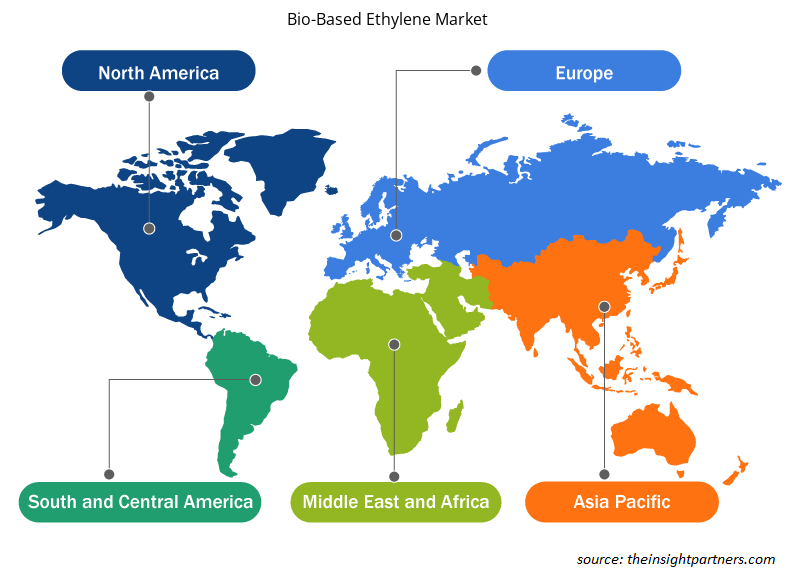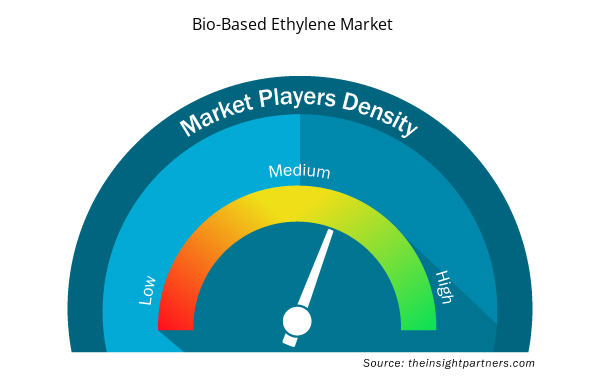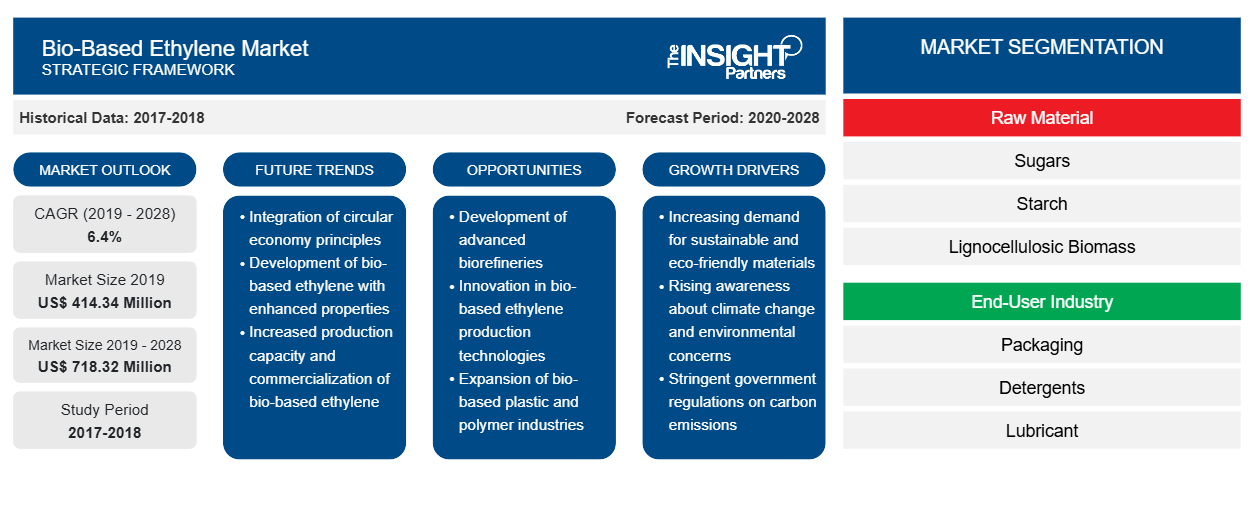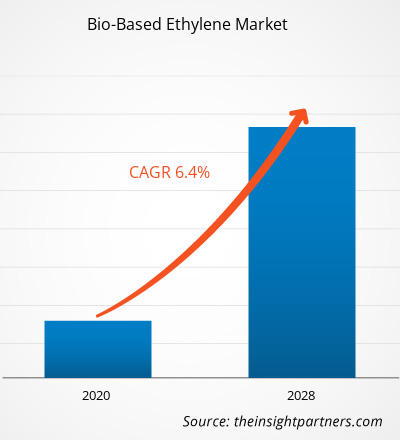バイオベースエチレン市場は2019年に4億1,434万米ドルと評価され、予測期間中に6.4%のCAGRで成長し、2028年までに7億1,832万米ドルに達すると予測されています。
バイオエチレンは、バイオエタノールに使用されるバイオマス原料から生産できます。バイオエチレンは、輸送燃料として使用されていることから、現在ではよく知られています。生産プロセスでは、糖類 (サトウキビ、テンサイ、サトウキビ)、デンプン (トウモロコシ、小麦)、リグノセルロース系バイオマス (木材、草) などのさまざまな天然資源が原料として使用されます。バイオエチレンは、燃料添加剤、包装材、洗剤製造メーカーから重要性を増しています。バイオベースの材料を求める業界は、自社製品にバイオエチレンを利用することを強く望んでいます。
2019年、ヨーロッパは世界のバイオベースエチレン市場で最大のシェアを占め、北米は予測期間中に市場で最も速いCAGRを記録すると予測されています。ヨーロッパの最大の市場シェアは、主にダウケミカルカンパニー、オキシローカーボンベンチャーズ(OCLV)、エナーケムなどの大手メーカーの存在に起因しています。北米は、この地域にある包装およびプラスチック製造業界でこの材料が幅広く使用されているため、予測期間中にバイオベースエチレン市場で大きなシェアを占めると予想されています。バイオエチレンは、デンプン、糖、リグノセルロースバイオマスなどのバイオベース材料から製造されています。バイオエタノールは主に輸送燃料のブレンドとして利用されており、この地域の自動車業界でさらに重要性を増しており、市場の成長にさらに影響を与えています。北米に住む人々、さらには業界関係者でさえ、今日では温室効果ガスの排出について非常に懸念しているため、石油化学製品の代替品としてバイオエチレンを採用しています。これにより、この地域のバイオエチレン市場の見通しはさらに明るくなります。
進行中のパンデミックは、化学および材料業界の状況を劇的に変え、バイオベースエチレン市場の成長に悪影響を及ぼしています。COVID-19の発生により、国境だけでなく国境も突然閉鎖されたため、業務効率が中断され、バリューチェーンが混乱し、損害とともに収益の損失が発生しています。混乱したバリューチェーンは原材料供給に悪影響を及ぼし、それが今度はバイオベースエチレン市場の成長に影響を与えています。しかし、経済が事業の復活を計画しているため、バイオベースエチレンの需要は世界的に高まると推定されています。パンデミックの間、消費者は商品をオンラインで注文することを好むため、食品包装業界や消費財業界からのバイオベースエチレンの需要が高まっています。
さらに、部分的なロックダウン、渡航禁止などの前向きな措置が各国政府によって講じられており、分散型発電や先進技術の導入も市場の成長を後押しすると予想されるもう1つの要因です。企業が講じている安全対策には、トラック運転手や訪問者との直接接触の制限、適切な衛生習慣の強化と周知、シフト交代時の徹底した衛生管理と人との接触の排除などが含まれています。これらすべての要素を考慮すると、パンデミック後の時代には、一部の用途分野からのバイオベースエチレンの需要が急増すると推測できます。
要件に合わせてレポートをカスタマイズする
このレポートの一部、国レベルの分析、Excelデータパックなど、あらゆるレポートを無料でカスタマイズできます。また、スタートアップや大学向けのお得なオファーや割引もご利用いただけます。
- このレポートの主要な市場動向を入手してください。この無料サンプルには、市場動向から見積もりや予測に至るまでのデータ分析が含まれます。
市場分析
化石燃料への依存を減らす必要性
エチレンは、多くの下流化学製品の原料として使用されています。エチレンは最大のバルク化学物質の 1 つであり、プラスチックの製造に広く使用されています。エチレンの幅広い用途により、今後数年間は需要が増加し続けると見込まれます。従来、エチレンは石油誘導体から製造されており、化石燃料の枯渇を招いています。この問題を克服するために、バイオマス原料はバイオベースエチレンの製造に対する信頼できる代替手段と考えられています。バイオエチレンは、木材、サトウキビ、コーンスターチなどのリグノセルロースバイオマスを使用して広く製造されているバイオエタノールから製造されるため、石油誘導体だけでなく化石燃料への依存も軽減されます。地元の資源を使用して生産されたバイオベース製品は、国の化石燃料輸入への依存を減らすこともできるため、国内経済を刺激することができます。
さらに、バイオベースエチレンは、製造時と使用時の両方で温室効果ガスの排出を削減します。しかし、バイオエチレンの環境パフォーマンスは、主にバイオエタノールの生産地域条件、土地利用の変化に起因する温室効果ガスの排出、および必要なエネルギーシステムの条件に依存します。しかし、バイオベースのエチレンは、化学産業の環境への影響を大幅に削減できます。したがって、化石燃料への依存を減らす緊急の必要性と環境の持続可能性に関する意識の高まりが、バイオベースのエチレン市場の成長を後押ししています。バイオベースのエチレンと石油ベースのエチレンは化学的に同一であるため、既存の生産能力と設備を使用して、通常どおりプラスチックを含む他の下流製品を生産することができ、既存の市場に大きな影響を与えることなく、市場の成長を支えるもう1つの要因となっています。
原材料に関する洞察
原材料に基づいて、世界のバイオベースエチレン市場は、糖、デンプン、およびリグノセルロース系バイオマスに分類されます。 2019年には、糖セグメントが最大のシェアで市場をリードしました。 バイオエチレンは、輸送部門で広く利用されている液体バイオ燃料であるバイオエタノールから生産されます。 サトウキビからの砂糖は、主にインドとブラジルでバイオエチレンを生産する際によく利用される原材料です。 ブラジルでは、安価なサトウキビ原料が広く利用できるため、バイオエチレンの生産は経済的に競争力があります。 サトウキビ、テンサイ、サトウキビは、スクロースが二糖類であるため分解が非常に簡単で、酵母を使用してバイオエタノールに直接発酵させることができます。 砂糖ベースのバイオエチレン生産は、プロセスでさらに電気を生産できるため、石油化学生産と比較して化石エネルギーを約60%節約すると推定されています。 サトウキビベースのバイオエチレンの生産コストも非常に低いです。化石燃料の使用によって発生する温室効果ガスの排出も、石油化学業界でバイオエチレンを利用することで最小限に抑えることができます。これらの利点により、ほとんどの業界ではさまざまな用途にバイオエチレンを採用しています。
エンドユーザー業界の洞察
最終用途産業の観点から見ると、世界のバイオベースエチレン市場は、包装、洗剤、潤滑剤、添加剤に分類されます。2019年には、包装セグメントが最大のシェアで市場をリードしました。バイオベースプラスチックまたはバイオプラスチックは、再生可能な生物資源から生産されます。たとえば、サトウキビは主にエチレンを調製するために処理され、エチレンはさらにポリエチレンの製造に利用できます。デンプンも処理して乳酸や同様にポリ乳酸(PLA)を抽出することができます。バイオプラスチックの特性は、材料ごとに異なる場合があります。PE、PET、PVCなどのバイオベースまたは部分的にバイオベースの耐久性のあるプラスチックは、従来のバージョンと非常によく似た特性を持っています。デンプンブレンド、バイオPE、PLA、バイオPETなどのバイオプラスチックは、主に包装用途で使用されています。繊維産業の繊維にも使用されています。バイオベースの材料から得られるコハク酸は、包装やその他の用途に非常に適しています。石油化学製品が引き起こす重大な健康問題により、分解性ポリマーに対する顧客の好みが高まっており、これは包装や繊維用途における製品需要を促進する好ましい要因となっています。
世界のバイオベースエチレン市場で活動している主要企業には、Braskem SA、The Dow Chemical Company、LyondellBasell Industries Holdings BV、SABIC、Oxy Low Carbon Ventures (OCLV) などがあります。主要な市場プレーヤーは、合併や買収、製品の発売などの戦略に注力し、世界的に地理的プレゼンスと消費者基盤を拡大しています。たとえば、2021 年 4 月には、Oxy Low Carbon Ventures とバイオエンジニアリングの新興企業である Cemvita Factory が、月産 1 トンのバイオエチレンパイロットプラントの建設と運用を発表しました。これは、炭化水素由来の原料の代わりに二酸化炭素 (CO2) を利用する共同の先進技術を使用して行われます。
バイオベースエチレン市場の地域別分析
予測期間を通じてバイオベースエチレン市場に影響を与える地域的な傾向と要因は、Insight Partners のアナリストによって徹底的に説明されています。このセクションでは、北米、ヨーロッパ、アジア太平洋、中東、アフリカ、南米、中米にわたるバイオベースエチレン市場のセグメントと地理についても説明します。

- バイオベースエチレン市場の地域別データを入手
バイオベースエチレン市場レポートの範囲
| レポート属性 | 詳細 |
|---|---|
| 2019年の市場規模 | 4億1,434万米ドル |
| 2028年までの市場規模 | 7億1,832万米ドル |
| 世界のCAGR(2019年 - 2028年) | 6.4% |
| 履歴データ | 2017-2018 |
| 予測期間 | 2020-2028 |
| 対象セグメント | 原材料別
|
| 対象地域と国 | 北米
|
| 市場リーダーと主要企業プロフィール |
|
バイオベースエチレン市場のプレーヤー密度:ビジネスダイナミクスへの影響を理解する
バイオベースエチレン市場は、消費者の嗜好の変化、技術の進歩、製品の利点に対する認識の高まりなどの要因により、エンドユーザーの需要が高まり、急速に成長しています。需要が高まるにつれて、企業は提供を拡大し、消費者のニーズを満たすために革新し、新たなトレンドを活用し、市場の成長をさらに促進しています。
市場プレーヤー密度とは、特定の市場または業界内で活動している企業または会社の分布を指します。これは、特定の市場スペースに、その規模または総市場価値と比較して、どれだけの競合相手 (市場プレーヤー) が存在するかを示します。
バイオベースエチレン市場で事業を展開している主要企業は次のとおりです。
- ブラスケム SA
- ダウ・ケミカル・カンパニー
- ライオンデルバセル インダストリーズ ホールディングス BV
- サビック
- エネルケム
免責事項:上記の企業は、特定の順序でランク付けされていません。

- バイオベースエチレン市場のトップキープレーヤーの概要を入手
レポートの注目点
- 世界のバイオベースエチレン市場における進歩的な業界動向は、プレーヤーが効果的な長期戦略を策定するのに役立ちます。
- 先進国市場と発展途上国市場で採用されているビジネス成長戦略
- 2017年から2028年までの市場の定量分析
- さまざまな業界におけるバイオベースエチレンの需要の推定
- 市場の成長を予測するために業界で活動するバイヤーとサプライヤーの有効性を示すPEST分析
- 競争的な市場シナリオとバイオベースエチレンの需要を理解するための最近の動向
- バイオベースエチレン市場の成長を牽引および抑制する要因と相まって、市場の動向と見通し
- 世界のバイオベースエチレン市場の成長に関する商業的利益を支える戦略を理解することによる意思決定プロセス
- 市場のさまざまなノードにおけるバイオベースエチレンの市場規模
- 世界のバイオベースエチレン市場の詳細な概要とセグメンテーション、および業界における動向
- 有望な成長機会があるさまざまな地域のバイオベースエチレン市場規模
バイオベースエチレン市場(原材料別)
- 糖類
- スターチ
- リグノセルロースバイオマス
バイオベースエチレン市場(エンドユーザー産業別)
- パッケージ
- 洗剤
- 潤滑剤
- 添加物
企業プロフィール
- ブラスケム SA
- ダウ・ケミカル・カンパニー
- ライオンデルバセル インダストリーズ ホールディングス BV
- サビック
- オキシ・ロー・カーボン・ベンチャーズ(OCLV)
- 過去2年間の分析、基準年、CAGRによる予測(7年間)
- PEST分析とSWOT分析
- 市場規模価値/数量 - 世界、地域、国
- 業界と競争環境
- Excel データセット


- Aircraft Landing Gear Market
- Real-Time Location Systems Market
- Airline Ancillary Services Market
- Military Rubber Tracks Market
- Human Microbiome Market
- Latent TB Detection Market
- Enzymatic DNA Synthesis Market
- Artwork Management Software Market
- Online Exam Proctoring Market
- Energy Recovery Ventilator Market

Report Coverage
Revenue forecast, Company Analysis, Industry landscape, Growth factors, and Trends

Segment Covered
This text is related
to segments covered.

Regional Scope
North America, Europe, Asia Pacific, Middle East & Africa, South & Central America

Country Scope
This text is related
to country scope.
よくある質問
The major players operating in the global bio-based ethylene market are Braskem S.A., The Dow Chemical Company, LyondellBasell Industries Holdings B.V., SABIC, and Enerkem.
In 2020, Europe held the largest share of the global bio-based ethylene market. The largest market share of this region is primarily attributed to the presence of major manufacturers in the region. Also, the rising production activities of bio-based ethylene is expected to fuel the market growth during 2020–2028. Moreover, strict environmental regulations also promote the practice of producing biofuel and bio energy in the region. The increase in demand for alternative source of fossil fuel and growing demand for bi ethylene from plastic industry are further propels the growth of the bio-based ethylene market.
Bio-ethylene is produced from bioethanol, which is a liquid biofuel that is widely utilized in the transportation sector. Sugar from sugarcane is highly utilized raw material to produce bio ethylene mainly in India and Brazil. In Brazil, production of bio-ethylene is economically competitive owing to the wider availability of cheap sugarcane feedstock. Sugar from sugarcane, sugar beets, and sweet sorghum are quite easy to break down since the sucrose is a disaccharide, which can be further directly fermented into bio ethanol utilizing yeast. Sugar based bio-ethylene production is estimated to save about 60% of fossil energy as compared to petrochemical production since the process can further produce electricity. The production costs of sugarcane-based bio-ethylene is also very low. The greenhouse gas emissions caused for using fossil fuel can also be minimized while utilizing bio ethylene in petrochemicals industry. Due to these benefits, most of the industries are adopting bio ethylene for various applications.
Trends and growth analysis reports related to Chemicals and Materials : READ MORE..
The List of Companies - Bio-based Ethylene Market
- Braskem S.A.
- The Dow Chemical Company
- LyondellBasell Industries Holdings B.V.
- SABIC
- Enerkem
- Linde
- Shell Global
- TotalEnergies
- Axens
- Sigma-Aldrich
The Insight Partners performs research in 4 major stages: Data Collection & Secondary Research, Primary Research, Data Analysis and Data Triangulation & Final Review.
- Data Collection and Secondary Research:
As a market research and consulting firm operating from a decade, we have published and advised several client across the globe. First step for any study will start with an assessment of currently available data and insights from existing reports. Further, historical and current market information is collected from Investor Presentations, Annual Reports, SEC Filings, etc., and other information related to company’s performance and market positioning are gathered from Paid Databases (Factiva, Hoovers, and Reuters) and various other publications available in public domain.
Several associations trade associates, technical forums, institutes, societies and organization are accessed to gain technical as well as market related insights through their publications such as research papers, blogs and press releases related to the studies are referred to get cues about the market. Further, white papers, journals, magazines, and other news articles published in last 3 years are scrutinized and analyzed to understand the current market trends.
- Primary Research:
The primarily interview analysis comprise of data obtained from industry participants interview and answers to survey questions gathered by in-house primary team.
For primary research, interviews are conducted with industry experts/CEOs/Marketing Managers/VPs/Subject Matter Experts from both demand and supply side to get a 360-degree view of the market. The primary team conducts several interviews based on the complexity of the markets to understand the various market trends and dynamics which makes research more credible and precise.
A typical research interview fulfils the following functions:
- Provides first-hand information on the market size, market trends, growth trends, competitive landscape, and outlook
- Validates and strengthens in-house secondary research findings
- Develops the analysis team’s expertise and market understanding
Primary research involves email interactions and telephone interviews for each market, category, segment, and sub-segment across geographies. The participants who typically take part in such a process include, but are not limited to:
- Industry participants: VPs, business development managers, market intelligence managers and national sales managers
- Outside experts: Valuation experts, research analysts and key opinion leaders specializing in the electronics and semiconductor industry.
Below is the breakup of our primary respondents by company, designation, and region:

Once we receive the confirmation from primary research sources or primary respondents, we finalize the base year market estimation and forecast the data as per the macroeconomic and microeconomic factors assessed during data collection.
- Data Analysis:
Once data is validated through both secondary as well as primary respondents, we finalize the market estimations by hypothesis formulation and factor analysis at regional and country level.
- Macro-Economic Factor Analysis:
We analyse macroeconomic indicators such the gross domestic product (GDP), increase in the demand for goods and services across industries, technological advancement, regional economic growth, governmental policies, the influence of COVID-19, PEST analysis, and other aspects. This analysis aids in setting benchmarks for various nations/regions and approximating market splits. Additionally, the general trend of the aforementioned components aid in determining the market's development possibilities.
- Country Level Data:
Various factors that are especially aligned to the country are taken into account to determine the market size for a certain area and country, including the presence of vendors, such as headquarters and offices, the country's GDP, demand patterns, and industry growth. To comprehend the market dynamics for the nation, a number of growth variables, inhibitors, application areas, and current market trends are researched. The aforementioned elements aid in determining the country's overall market's growth potential.
- Company Profile:
The “Table of Contents” is formulated by listing and analyzing more than 25 - 30 companies operating in the market ecosystem across geographies. However, we profile only 10 companies as a standard practice in our syndicate reports. These 10 companies comprise leading, emerging, and regional players. Nonetheless, our analysis is not restricted to the 10 listed companies, we also analyze other companies present in the market to develop a holistic view and understand the prevailing trends. The “Company Profiles” section in the report covers key facts, business description, products & services, financial information, SWOT analysis, and key developments. The financial information presented is extracted from the annual reports and official documents of the publicly listed companies. Upon collecting the information for the sections of respective companies, we verify them via various primary sources and then compile the data in respective company profiles. The company level information helps us in deriving the base number as well as in forecasting the market size.
- Developing Base Number:
Aggregation of sales statistics (2020-2022) and macro-economic factor, and other secondary and primary research insights are utilized to arrive at base number and related market shares for 2022. The data gaps are identified in this step and relevant market data is analyzed, collected from paid primary interviews or databases. On finalizing the base year market size, forecasts are developed on the basis of macro-economic, industry and market growth factors and company level analysis.
- Data Triangulation and Final Review:
The market findings and base year market size calculations are validated from supply as well as demand side. Demand side validations are based on macro-economic factor analysis and benchmarks for respective regions and countries. In case of supply side validations, revenues of major companies are estimated (in case not available) based on industry benchmark, approximate number of employees, product portfolio, and primary interviews revenues are gathered. Further revenue from target product/service segment is assessed to avoid overshooting of market statistics. In case of heavy deviations between supply and demand side values, all thes steps are repeated to achieve synchronization.
We follow an iterative model, wherein we share our research findings with Subject Matter Experts (SME’s) and Key Opinion Leaders (KOLs) until consensus view of the market is not formulated – this model negates any drastic deviation in the opinions of experts. Only validated and universally acceptable research findings are quoted in our reports.
We have important check points that we use to validate our research findings – which we call – data triangulation, where we validate the information, we generate from secondary sources with primary interviews and then we re-validate with our internal data bases and Subject matter experts. This comprehensive model enables us to deliver high quality, reliable data in shortest possible time.


 このレポートの無料サンプルを入手する
このレポートの無料サンプルを入手する